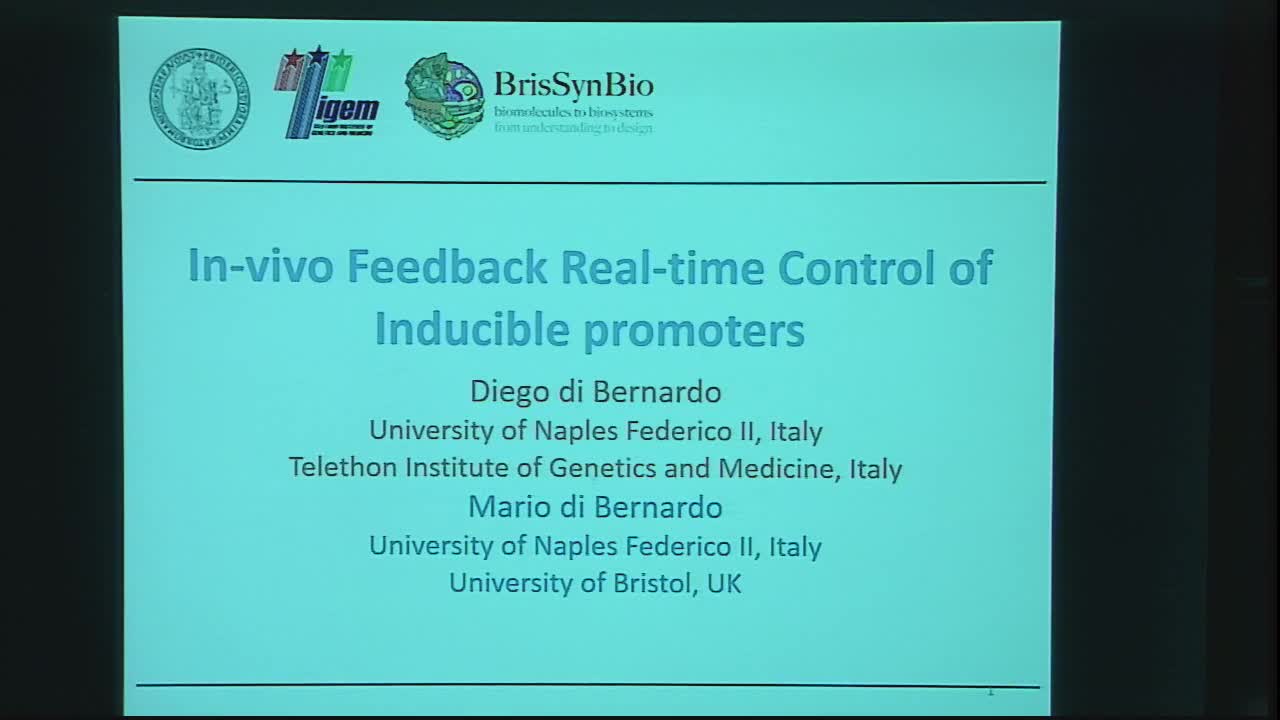In-vivo Feedback Real-time Control of Synthetic Gene Networks
Presenters
November 18, 2015
Keywords:
- automatic control; gene regulatory networks; microfluidics
Abstract
Diego and Mario di Bernardo (University of Naples Federico II and University of Bristol)
Automatic control of gene expression in living cells is of paramount importance to characterise both endogenous gene regulatory networks and synthetic circuits. In addition, such a technology can be used to maintain the expression of synthetic circuit's components in an optimal range, in order to ensure reliable performance. In this talk we present a method based on microfluidics to automatically control gene expression in both yeast and mammalian cells. We first discuss an application to force yeast cells to express a desired fixed, or time-varying amount of a reporter protein. Using this relatively easier biological experimental system, we compare the performance of three different control strategies first in-silico and then in-vivo. Specifically, we focus on three different control algorithms; a simpler Proportional-Integral (PI) controller (with and without anti-windup), a Model Predictive Control (MPC) strategy, which have already been used to control gene expression, and the Zero Average Dynamics (ZAD), a control technique used to implement sliding mode control in power electronic systems which is proposed here for the first time as a viable strategy for biological systems.
To contrast their performance we use as an experimental test-bed the most commonly used inducible promoter in yeast: the Galactose-responsive GAL1 promoter. We evaluate how each of the three control strategies performs two control tasks: setpoint regulation, where cells are forced to express a desired constant fluorescence level of a reporter protein downstream of the GAL1 promoter, or tracking, where they have to follow a time-varying fluorescence reference signal. As control input, in our platform either glucose or galactose can be provided to the cells hence, in all cases, the aim of the controller is to modulate an appropriate pulse train to achieve the control goal.
We demonstrate that both the MPC and ZAD control strategies can successfully regulate gene expression from the GAL1 promoter in living cells for thousands of minutes. The MPC controller can track fast reference signals better than ZAD, but with an higher actuation effort due to the large number of input switches it requires. Conversely, as expected, the performance of the PI controller complemented by a PWM modulator and an anti windup scheme is comparable to that achieved by the MPC and the ZAD controllers only for the set-point regulation.
To further illustrate the viability of the methodology, we also discuss the first application of gene expression control in mammalian cells to achieve a set-point control task. Two different model-independent control algorithms (relay and PI) are used to force a monoclonal population of cells to express an intermediate level of d2EYFP equal to 50% of its maximum expression level, for up to 3,500 minutes.
Finally, we discuss some of the pressing open challenges related to the design and application of algorithms for in-vivo control of cell populations and briefly present some of our ongoing and future work in Naples and Bristol.
REFERENCES
[1] F. Menolascina, M. di Bernardo, and D. Di Bernardo, “Analysis, design and implementation of a novel scheme for in-vivo control of synthetic gene regulatory networks,” Automatica, vol. 47, no. 6, pp. 1265–1270, 2011.
[2] G. Fiore, F. Menolascina, M. di Bernardo, and D. di Bernardo, “An experimental approach to identify dynamical models of transcriptional regulation in living cells,” Chaos, vol. 23, no. 2, p. 025106, 2013.
[3] F. Menolascina, G. Fiore, E. Orabona, L. De Stefano, M. Ferry, J. Hasty, M. di Bernardo, and D. Di Bernardo, “In-Vivo Real-Time Control of Protein Expression from Endogenous and Synthetic Gene Networks,” PLoS Comput Biol, vol. 10, no. 5, e1003625, 2014.
[4] G. Fiore, G. Perrino, M. di Bernardo, D. di Bernardo, “In-vivo real-time control of gene expression: a comparative analysis of feedback control strategies in yeast”, ACS Synthetic Biology, under review, 2015
[5] C. Fracassi, L. Postiglione, G. Fiore, D di Bernardo "Automatic Control Gene Expression in mammalian cells", ACS Synthetic Biology, in press.
